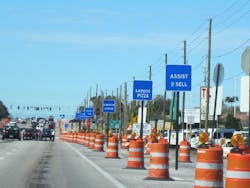By: LuAnn Theiss; Contributing Author
Closely spaced driveways in a Florida work zone.
Identifying business driveways in a roadway construction zone can be difficult, particularly at night.
Darkness can mask visual cues that are available to help drivers during the daytime. In addition, the driveway drums are the same as all the other drums used throughout the work zone.
Even though the drums are more closely spaced around driveways in an effort to provide better delineation, they may still appear to be a cluttered and confusing mess from the viewpoint of approaching drivers. Figure 1 illustrates this from the perspective of a driver. While the driveway delineation configurations shown on plan sheets can be quite clear, closely spaced drums can also obstruct the view of oncoming traffic for drivers exiting the driveway.
It is no surprise that these situations can potentially create safety problems in work zones. Both the Florida Department of Transportation (FDOT) and the Texas Department of Transportation (TxDOT) have recently funded research to look at improving driveway delineation in work zones. Researchers at the Texas A&M Transportation Institute (TTI) were up for the challenge. They first identified delineation alternatives that might help drivers to better locate driveway openings; they then tested those alternatives using eye-tracking technology to study driver behavior around work-zone driveways where the delineation alternatives were deployed.
Looking for an opening
Using a closed-course study conducted at the TTI Riverside Campus Proving Grounds, the researchers quickly found that using combinations of channelizing devices whose height, shape and retroreflective delineation patterns varied from that of the drums used throughout the work zone did a better job of helping drivers identify driveways earlier, so as to make a turn into the proper gap between the channelizing devices. Both research sponsors chose to use devices already listed in the Manual on Uniform Traffic Control Devices for their respective research projects. FDOT chose low-profile (less than 21 in. in height) longitudinal channelizing devices (LCD), while TxDOT chose the low-profile LCD and 42-in.-tall two-piece cones (i.e., grabber style or looper style). Traffic operations data on both projects showed no negative impacts from using the delineation alternatives.
Treatment 1: Low-profile 18-in.-tall LCD on the main lane with 42-in.-tall cones in the driveway radii.
Treatment 2: 42-in.-tall cones on the main lane with low-profile 18-in.-tall LCD in the driveway radii.
Treatment 3: Standard 36-in. drums on both the main lane and in the driveway radii.
For the eye-tracking study, the researchers set up the driveway treatments at nine different driveways located in two different TxDOT reconstruction projects. The treatments, shown in Figures 2 through 4, were:
(1) Low-profile 18-in.-tall LCD on the main lane with 42-in.-tall cones in the driveway radii;
(2) 42-in.-tall cones on the main lane with low-profile 18-in.-tall LCD in the driveway radii; and
(3) Standard 36-in. drums on both the main lane and in the driveway radii.
Eighty-one paid participants drove an instrumented vehicle through the work zone while being monitored with eye-tracking equipment. They were asked to identify specific business driveways and make turns into those driveways. Their visual attention when approaching driveways was recorded by dash-mounted infrared cameras, which were calibrated for each participant prior to driving through the work zone. This information was overlaid onto a forward scene video captured from a separate time-synchronized camera.
As shown in the sidebar, the green circle indicated the location of the driver’s glance, in this case, at the driveway opening. For each driveway approached, the participant glances were categorized into regions. Driver glances at the treatment and at the driveway sign were relatively easy to identify. Glances at the lane lines or at nearby traffic were assumed to be for the purpose of lane-keeping. In other words, the driver was monitoring his/her speed and/or lane position with respect to the lane line and/or other vehicles. The number of glances in each region, as well as the duration of each glance, was recorded. The number of missed turn attempts and the participant’s opinion of the driveway treatments also were recorded.
“We thought that participants would glance more frequently and for longer durations at treatments that made it easier to identify a particular driveway,” said Theiss. “This is based on the idea that participants would have to do less scanning along the roadside looking for the driveway opening as they traveled through the work zone.” If the treatment made the driveway more difficult to identify, the percentage of glances in other regions would be higher.
The results showed that the participants appeared to locate the driveway more easily when the alternative delineation treatments were used, as evidenced by a higher percentage of roadside glances at the driveway access point. The data also suggests that drivers may have some difficulty identifying the driveways with standard drum treatments.
In addition, the treatment glance duration data showed that using LCD in the driveway radii resulted in longer glances than the other treatments at night. This was considered favorable, since more time spemt looking at the treatment was indicative of its success in attracting driver attention.
Some of the participants actually missed the driveway where they were asked to turn. The standard drum-treatment driveways had the highest percentage of missed turns at night. This suggests that the current practice of delineating driveways with drums, which look the same as the rest of the work-zone channelization, is somewhat challenging to motorists.
In a brief survey, participants also indicated that they preferred either alternative driveway treatment over the standard channelizing drums that were used all along the roadside of the work zones.
Overall, the results showed that both driveway delineation alternatives provided visual differences when compared to the standard drum delineation in both daytime and nighttime conditions. Differences in height, shape and retroreflective delineation patterns can provide visual cues to drivers that help them readily locate and identify driveways in work zones.
The full research report can be found at: http://tti.tamu.edu/documents/0-6781-1.pdf. ST
About The Author: Theiss is an associate research engineer at the Texas A&M Transportation Insitute, College Station, Texas. She can be reached at [email protected].






